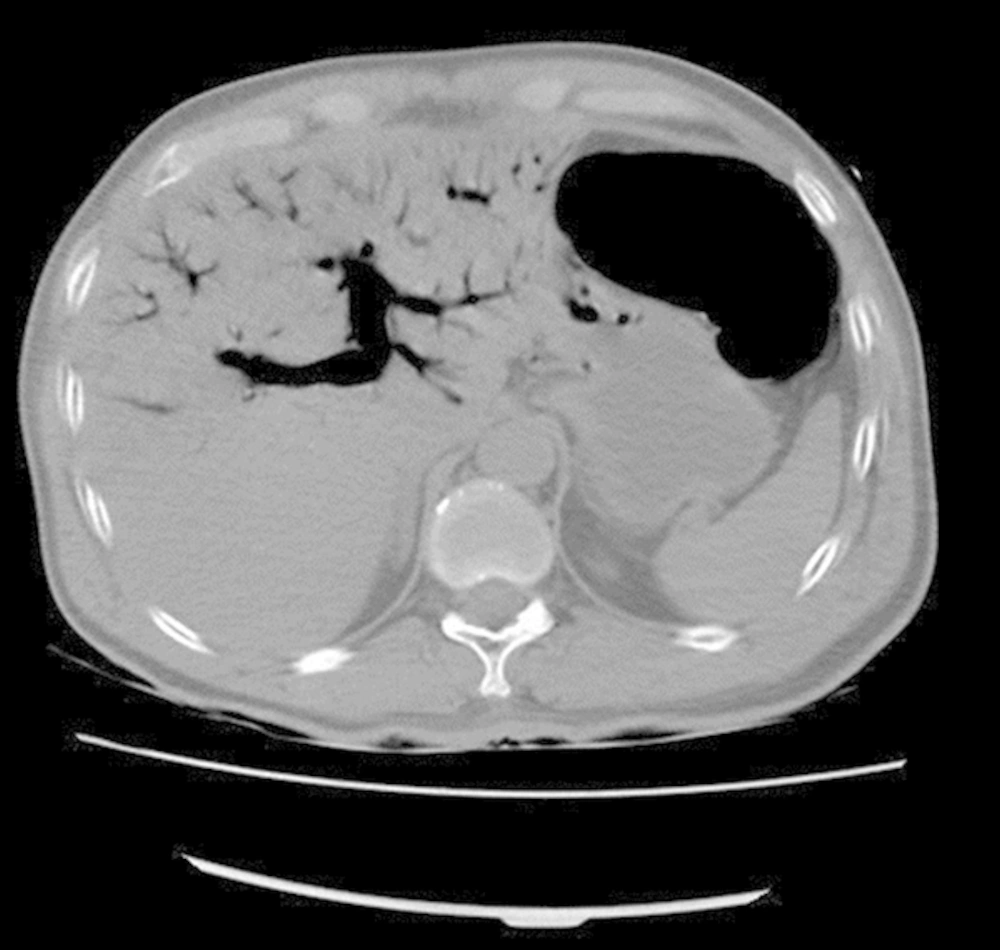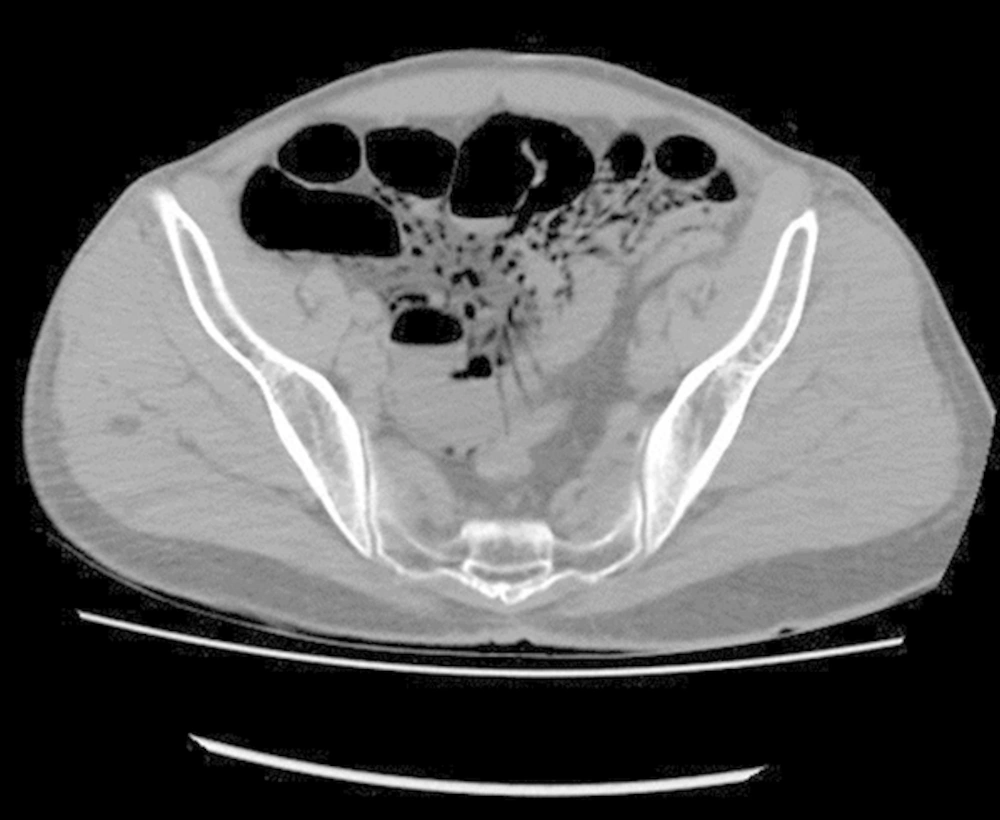1. Introduction
Amphetamines and methamphetamines are among the most significant central nervous system stimulant drugs of abuse. The most commonly reported symptoms of these patients are altered mental status including agitation, hallucination, suicidal ideation, delusions, and confusion. Symptoms of agitation may vary widely and include screaming loudly, moving uncontrollably, being aggressive, and/or being hyperactive [1]. This is while this agitation can masquerade other very important complications of amphetamine/methamphetamine abuse. As known, amphetamine can result in significant life-threatening complications such as myocardial infarction (MI), pneumothorax, pneumomediastinitis, intestinal ischemia, and intracranial hemorrhages [2, 3]. These complications cannot be detected easily in sedated patients unless they are always considered by the treating physician. We present a 50-year-old case of acute inhalational toxicity with amphetamine/methamphetamine who was followed and treated for agitation almost 12 hours in our ward. We aim to describe the pitfalls in diagnosis and treatment of these patients a physician should always have in mind for the best management.
2. Case Presentation
A 50-year-old amphetamine-addicted male was admitted to our emergency department (ED) at 4:35 AM with hallucination, disorientation, and epigastria pain almost 12 hours after the inhalational abuse of amphetamine/ methamphetamine. On admission, his blood pressure, pulse rate, respiratory rate, and core temperature were reported to be 120/75 mmHg, 94 bpm, 18/minutes, and 36.8°Ċ. Pupils were mid-sized and reactive to the light and O2 saturation was 99%. Bowel sounds were auscultated while the epigastric pain was present without guarding and rebound tenderness. Ten mg of diazepam was intravenously administered and since ICU beds were not available, he was transferred to toxicological ward. The first lab tests were: white blood cell = 18400, hemoglobin = 14.7, platelets = 145000, urea = 58, creatinine = 1.9, aspartate transaminase = 515, alanine transaminase = 255, creatine phosphokinase = 296, lactate dehydrogenase = 2069, alkaline phosphatase = 140, total bilirubin = 1.3, direct bilirubin = 0.4, serum sodium = 139, serum potassium = 5.2, and arterial blood gas (ABG) analysis of pH = 7.15, pCO2 = 54.4, HCO3 = 18.5, and base excess = -10.7. The patient was put on conservative treatment by our residents and re-evaluated after 10 h by the attending physician. Within this period, the patient was on intravenous infusion of midazolam due to continuous agitation. On the second visit (by the attending physician), the patient’s ABG parameters changed to pH= 7.18, pCO2 = 31, and HCO3 = 11. The patient became tachycardic (132 bpm), was intubated and sent to medical toxicology ICU. The attending physician asked brain and abdominal CT without contrast to rule out brain hemorrhage and body packing/stuffing abdominal CT in Figures 1 and 2 which showed massive air in the abdominal blood vessels and intestinal wall pneumatosis suggesting intestinal ischemia and rupture followed by air emboli into the portal and mesenteric veins.
Surgical consult was requested; meanwhile, the patient got worse and developed mottling and bradycardia. He did not respond to intravenous atropine and arrested suddenly. Cardiopulmonary resuscitation was commenced which was unsuccessful and the patient was announced legally dead about 45 minutes later. In medical examination at the morgue, gas chromatography/mass spectrometry (GC/MS; Agilent 7890A, USA) with a mass detector (5975C) was used for qualitative amphetamine and methamphetamine detection in urine sample and showed positive results. Intestinal ischemia was announced as the cause of intestinal loop pneumatosis and rupture and massive air emboli in the portal veins and superior mesenteric vein. Written informed consent was obtained from the patient’s family for publication of this case report and accompanying images.
3. Discussion
Our case study shows that stimulant overdose may lead to acute abdominal emergency. Infusion of benzodiazepines as an effective treatment for control of toxicity may mask colon ischemia and further peritonitis and abdominal sepsis. Great caution should be undertaken to avoid mismanagement of patients.
Acute mesenteric ischemia is a life-threatening condition which causes a mortality rate of 50 - 90% [4]. Some drugs have been shown to cause colonic ischemia including conjugated estrogen, ergotamine derivatives, catecholamines, dextroamphetamine, vasopressin, digoxin, cocaine, and methamphetamine [5]. Most of them modify splanchnic blood flow. Amphetamines release neurotransmitters (norepinephrine and dopamine) from presynaptic axonal terminals and inhibit their removal (axonal re-uptake) causing vasoconstriction [6].
As every clinical toxicologist knows, acute amphetamine and methamphetamine toxicities may accompany with severe and potentially life-threatening complications such as MI, brain hemorrhages, acute hepatic and renal failure, rhabdomyolysis, and hyperthermia [2]. Other less common complications including pneumothorax, pneumomediastinitis, and intestinal ischemia and rupture should also be borne in mind in these patients. This is especially very important with the current growing rate of abuse with these substances [7, 8].
General approach for the management of stimulant toxicity is conservative management with administration of benzodiazepines which can masquerade some of the most significant life-threatening complications including intracranial hemorrhages or intestinal ischemia and/or rupture. If the treating physician does not think about the possibility of occurrence of these complications in his/her mind, he/she may miss the patient. Our case is a clear example of this missing. Our residents managed him for agitation in the ward for almost 12 hours without paying attention to the possible causes of his agitation including cerebrovascular accidents, MI, and/or rupture complications. No abdominal examination had been performed while a simple examination of the abdomen could detect patient’s deterioration and abdominal rebound tenderness and guarding. With such extensive air emboli and intestinal rupture the patient might have not survived any way. However, on-time diagnosis of such complications may be life-saving in other cases.

